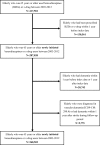Benzodiazepines, z-Hypnotics, and Risk of Dementia: Special Considerations of Half-Lives and Concomitant Use
- PMID: 31802436
- PMCID: PMC7007460
- DOI: 10.1007/s13311-019-00801-9
Benzodiazepines, z-Hypnotics, and Risk of Dementia: Special Considerations of Half-Lives and Concomitant Use
Abstract
The utilization of benzodiazepines (BZDs) and z-hypnotics has substantially increased with the aging of the population, but the risk of BZDs and z-hypnotics in the development of dementia remains a strong concern. This cohort study aimed to evaluate the risk of BZDs and z-hypnotics for subsequent dementia development with a special consideration of their half-lives and the concomitant use of these medications. People aged 65 years and older who were newly prescribed oral BZDs or z-hypnotics between 2003 and 2012 were identified from Taiwan's National Health Insurance Research Database. All BZDs were categorized as long-acting drugs (≥ 20 h) or short-acting drugs (< 20 h) for further comparisons, and data were collected on a quarterly basis, starting on the first date of drug prescription and ending on the date of death, occurrence of dementia, or end of the follow-up period (December 31, 2012), whichever came first. All dementia events except vascular dementia occurring during the follow-up period were identified. Among 260,502 eligible subjects, short-acting BZDs and z-hypnotics users were at greater risk of dementia than long-acting users [adjusted odds ratio (95% confidence interval) in short-acting BZD users, 1.98 (1.89-2.07); z-hypnotic users, 1.79 (1.68-1.91); and long-acting BZD users, 1.47 (1.37-1.58)]. In addition, subjects concomitantly using 2 or more BZDs or z-hypnotics had a higher risk of dementia than those who used 1 of these drugs (4.79 (3.95-5.81)). The use of BZDs and z-hypnotics was strongly associated with the risk of dementia development, especially the short-acting BZDs, z-hypnotics, and concomitant use of multiple agents. These findings deserve further interventional studies for clarification.
Keywords: Benzodiazepines; dementia; elderly; half-life; z-hypnotics.
Figures
References
-
- Hsiao F-Y, Hsieh P-H, Gau C-S. Ten-year trend in prescriptions of z-hypnotics among the elderly: a nationwide, cross-sectional study in Taiwan. Journal of Clinical Gerontology and Geriatrics. 2013;4(2):37–41. doi: 10.1016/j.jcgg.2012.12.001. - DOI
Publication types
MeSH terms
Substances
LinkOut - more resources
Full Text Sources
Medical


